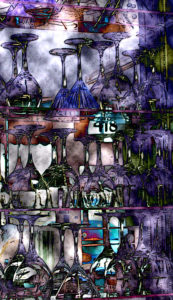There are a lot of factors that can influence the way wine tastes to someone. From the lighting in the room, to the music you’re listening to, to what you’re eating, or to how you generally feel that day, there are a lot of outside stimuli that can change your experience with

Photo courtesy Flickr user Umbria Lovers
a given wine.
Some more recent research has focused on the sensation of physical touch, and has found that the flavors and overall acceptability of various food and beverages can be influenced by the texture of the packaging itself. For example, one study found that biscuits taken from a bowl with a rough surface tasted crunchier and harder than those taken from a smooth-surfaced bowl. Additionally, for a beverage example, another study found that hot chocolate and coffee tasted from a round cup tasted sweeter and “less intense” than the same drinks tasted from a cup with more angular features.
Dubbed as “sensation transference” in the 1950s, the theory is that someone’s feelings about a particular extrinsic characteristic (i.e. the texture of the packaging) can influence their rating of the actual product itself. In 2011, another study further defined this theory as “affective ventriloquism”, when sensation transference affects someone’s rating of a product (like food or beverages).
Touch itself is known to alter emotional responses in general. Specifically, one 2013 study looking at blood flow in the brain found that touching fabric samples led to a calming response (decreased activity in the orbitofrontal cortex) compared to touching a sample of metal.
While research on sensation transference and affective ventriloquism is growing, according to a new study just accepted into the International Journal of Gastronomy and Food Science, there isn’t a lot of research done on how these theories impact perception of aromas, and specifically aromas in wine.
The overall goal of this new study was to examine how touch might influence the wine tasting experience, or more specifically, how touch may or may not influence both the taste of the wine as well as the aroma and mouthfeel.
Brief Methods
PRE-TEST
First, the researchers conducted a “pre-test” to ensure that this theory of sensation transference and affective ventriloquism would even work in a wine tasting setting.

Photo courtesy Flickr user Steve Snodgrass
This pre-test was conducted during breaks at a neuroscience and wine symposium in Barcelona, Spain.
The experiment was laid out as such: imagine a long table: at one end, lay pieces of sandpaper and at the other end, lay a swatch of soft velvet. Next to each of these samples sat an opaque black glass of off-dry Chardonnay. Participants were encouraged to taste the wines at each end of the table while touching the sandpaper/velvet samples, and were asked to evaluate the wine’s pleasantness, flavor intensity, and sweetness.
There were 40 participants total for the pre-test (22 men, 16 women, 2 unreported; between the ages of 18-60).
MAIN STUDY
After some encouraging results from the pre-test (see results section below), the researchers forged ahead with the main study.
60 participants completed this main study (36 women, 22 men, 2 unreported; between the ages of 23-66). 40 of these participants self-reported as wine novices, 14 as intermediates, and 1 as an expert (5 did not report wine expertise levels). Participants were recruited throughout London (study took place at Oxford University) via mailing lists and social media recruitment methods.
Participants sat at a table with two tactile samples in front of them: sandpaper and velvet; as well as two glasses of wine: a red dessert wine. Participants were not aware that both glasses contained the same wine.
Participants were asked to smell the two glasses of wine, one at a time, while touching one of the tactile samples with their dominant hand. Then they switched to the other tactile sample when smelling each of the wines one at a time. Participants were asked to rate the aroma intensity, acidity, fruitiness, and pleasantness for each wine.
For the tasting portion, the set-up was the same of the smelling portion of the test, except instead of smelling the wine they tasted a mouthful of wine. After the tasting/touching, participants were again asked to rate the wines, this time the taste and not the aroma, for acidity, sweetness, tannins, and pleasantness.
To get a better idea of the actual tasting set up, half of the participants ended up touching sandpaper while they smelled or tasted the first wine, then they touched the velvet while smelling or tasting the second wine. The other half of the participants did the opposite – they touched the sandpaper while smelling/tasting the second wine and touched the velvet while smelling/tasting the first wine.
Selected Results
PRE-TEST
- The wine tasted while touching the velvet samples tasted significantly sweeter than the wine while touching the sandpaper.
- Touching the velvet or sandpaper did not influence flavor intensity or wine pleasantness.
MAIN STUDY
- The wine smelled significantly fruitier when touching the velvet samples compared to when touching the sandpaper.
- Touching the velvet/sandpaper did not affect the aroma’s intensity, acidity, or pleasantness.
- For the tasting portion, the wines tasted significantly sweeter when touching the velvet compared to when touching the sandpaper.
- The wine tasted when touching the velvet was rated as significantly more pleasant than the wine tasted when touching the sandpaper.
Conclusions
Overall, the results of this study suggest that sensation transference and affective ventriloquism theories apply to wine tasting, in both aroma and taste/flavor. Specifically, when touching the soft velvet samples, the wines tasted significantly sweeter and more pleasant than the same wines tasted when touching the sandpaper. In regards to aroma alone, wines smelled much fruitier when the velvet samples were touched compared to when the sandpaper samples were touched.
How could this be? The researchers postulated this reasoning: in 2014, a study found that people prefer smoother textures to rougher ones. It’s possible that this innate preference for velvet over sandpaper could have transferred directly onto the wines themselves, resulting in more pleasant flavors/aromas of the wines tasted when in contact with the velvet. Since sweetness has also been associated with pleasantness by other studies, this could also explain why the soft texture of the velvet might make the wines taste even sweeter to participants.
Of course, this is was a very small study with a very basic set-up. When would you ever be in

Photo courtesy Flickr user Sharon Drummond
a wine tasting scenario where you’re rubbing fabric samples at the same time? Probably never. Even though it’s still out-there, physically wrapping the fabric samples around the stem may have made for a more “natural” setting that just rubbing a swatch on the table. Despite the “weirdness”, however, this result could pave the way for further research in the sensation transference and affective ventriloquism in wine tasting—specifically when it comes to the packaging itself (i.e. wine glasses).
Perhaps playing around with the tactile sensations of the wine glass itself could influence how the wine tastes. Perhaps a wine glass with rougher stems could lessen the sensation of sweetness, if that’s why you’re going for. Or perhaps changing the shape of the stem (rounder versus square/more angular) might influence how the taster evaluates the wine in the glass.
It would also be interesting to see how different expertise levels evaluate the wines in this kind of set-up. Most of the participants in this study were considered beginners—would wine experts be even more sensitive to the tactile test? Or perhaps they would be able to block out the influence of touch?
Lots of possibilities, lots of unanswered questions, but kind of fun stuff anyway!
Source:
Wang, Q.J., and Spence, C. 2018. A smooth wine? Haptic influences on wine evaluation. International Journal of Gastronomy and Food Science. https://doi.org/10.1016/j.ijgfs2018.08.002.
